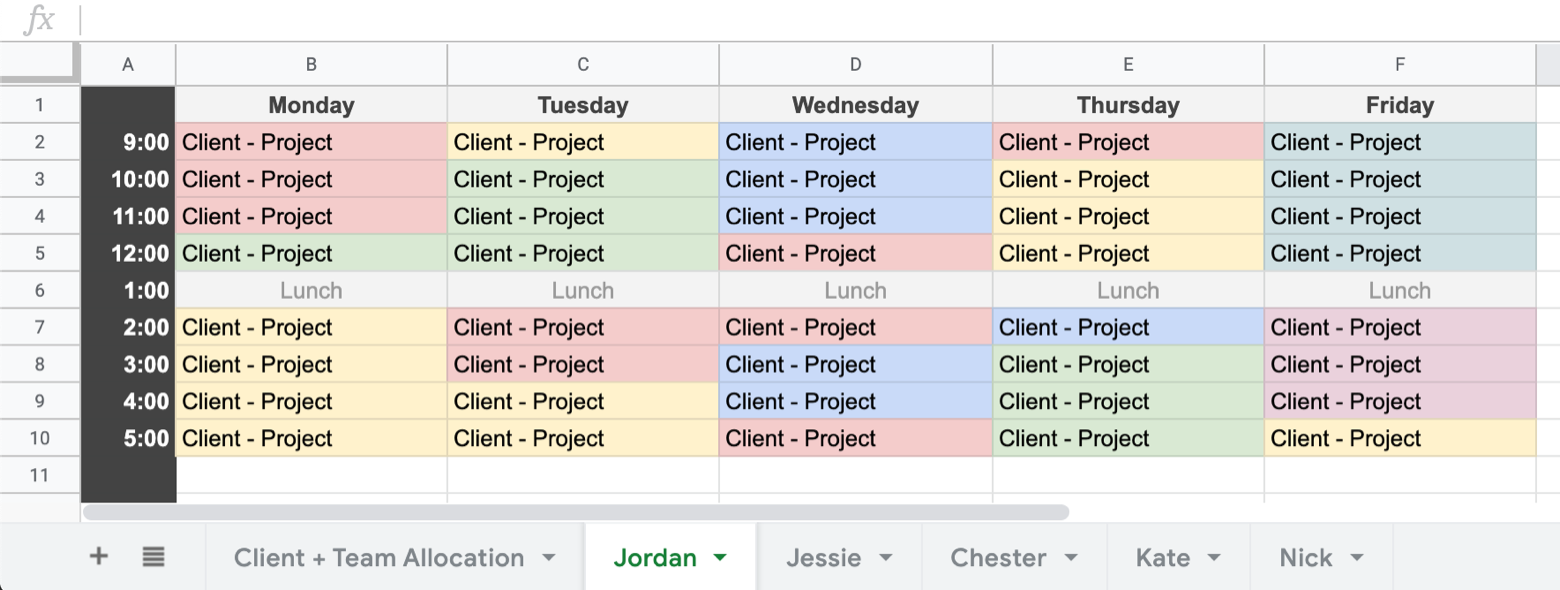Tetris for UX Team Building and Efficiency

Delivering meaningful experiences to customers requires our team to move effectively and always hit deadlines. As the leader of our team, I’m ensuring we have the correct resources allocated to the correct work at the correct time. My secret? Tetris.
What is Weekly Tetris? Not an 80s video game (sorry). “Weekly Tetris” helps us segment workload and manage tasks across different team members. While most project management software has ample workload tracking functionality, we’ve found that a simple shared Google document works best. The gist of the system is this: we stack “blocks” of time for projects, color-coded by team member, over an hourly schedule. The result looks a lot like a Tetris board. This works because it:
- Allows us to visualize workloads
- Shows us where workloads can be rebalanced
- Displays exactly who has time at any given moment
- Grants our team the autonomy to tackle projects in creative ways within the blocks
- Ensures we are making and keeping client commitments

Where did the idea come from? There is an adage about filling a jar with sand and rocks. If you fill a jar with sand first, and then add rocks to it, you won’t be able to fit the rocks completely. But if you add the rocks first, then let the sand fill the spaces, everything magically fits. It’s important to get the big rocks in place first.
Product teams have similar problems with their time and resource constraints. When you have a limited amount of time, the way you allocate your resources and attention matters. It isn’t always easy to have the correct priorities outlined in the correct order, and priorities are always shifting.
With Tetris, we take a much simpler approach. We remove the complexity and get to what matters most. Prioritization with Tetris allows us to tackle more projects and have the right focus time while exceeding our client’s expectations every time. It allows us to see allocation and easily shift and move it to adapt within the week.
How exactly does the process work? Our planning meetings occur each Friday or Monday. We have a great project leader that facilitates the delegation meeting and, afterwards, sends screenshots of what everyone has on their plate.
The meeting itself is actually just as important as the Tetris board output. The time-slotting process ensures buy-in and accountability while allowing us to operate in an efficient and committed space, once it’s planned. Everyone knows what everyone else is working on, and everyone knows who the backup is on a certain project. Tetris is as much about our mindset to deliver value, as it is the actual output from the board. We are all playing a role to deliver value every day. If one block is out of sync the whole schedule could fall apart.
What else has Tetris helped with? As a leader, it’s important for me to understand how much work everyone has, but it’s also important to empower the team to come together in the interest of the client. Team dynamics, mindset and culture are core to any high-functioning team, and Tetris connects each person’s work while building trust and accountability.
Initially, there were some reactions from the team about the pre-slotting of work being robotic. People were also concerned about being potentially over-scheduled. The reality is that this simple system actually protects creative time, increases focus time and prevents over-scheduling. It creates “what by when” agreements. It defends our team’s sanity, while also defending client priorities and investment. When a schedule changes or we run into a challenge on a project, we already have a map to review and adjust as needed. And when we are getting full, we know exactly where to add just the right help so we can deliver reliably.
As a leader, I don’t have to constantly check in, because I already know what work is getting completed by whom and by when. We have created a committed space. Likewise, our people don’t have to constantly check back to see what’s next “on the list” because they already know. Everyone holds everyone else accountable for their weekly delivery.
Our values center on our ability to “deliver value every day” with an environment that relies upon “the speed of trust”, and Tetris is one leadership tool we use to help us consistently deliver meaningful experiences to our clients.